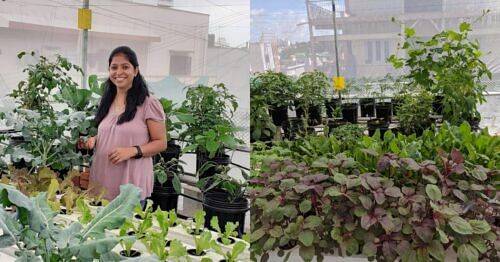
Jincy Samuel's patio is studded with a rainbow of colors, from purple and burgundy to green, on a rooftop in Richards Town, amidst the chaos of Bengaluru traffic.
If you look attentively, you will realize that it is not a conventional garden with flower beds, but one with prawns and tilapia fish that mix with the vegetable and herb plants.
Jincy grows her plants utilising new methods such as hydroponics and aquaponics, which are distinct from typical soil-based techniques
Putting fish to work
When the country went into lockdown in March of last year, it became normal to witness long lines outside supermarkets. During this time, Jincy's husband, Benson Samuel, recommended that they start producing their own food. "We had to go and stand in long queues at grocery stores during the lockdown, which was exhausting. My mother-in-law and I have always enjoyed gardening, but the lockdown proved to be a game-changer for us," Jincy adds.
Jincy and her husband have no formal agricultural training. Jincy holds an MBA and has worked in BPOs, running a cryptocurrency platform, and has worked in the food business, while her husband has worked in IT.
Jincy and her husband, who were both self-employed and had no prior knowledge of how to produce their food so they began devoting time to research possible methods they could apply. They were lured to hydroponics and aquaponics technologies for two reasons.
First is the restricted amount of area available, and second is the rate of growth as compared to traditional soil-based gardening.
"A hydroponic system can be simply installed in an urban household. I compared soil-grown plants to hydroponic ones. I've discovered that growth is more rapid now that the environment is better regulated. Because you have a polyhouse, there are no pests that come and harm the plants, and you can also manage what nutrients the plants receive. "This generates greater outcomes than soil-based farming," Jincy says.
A nutrient-rich, aquatic solution is flushed through the roots of the plant in hydroponics to give the essential resources for maximum development.
"There is a reservoir in the hydroponic system where you add water together with basic nutrient salts such as potassium and nitrogen, in proportion to what the plants require and how much water is consumed," Jincy explains.
Aquaponics, on the other hand, is a hybrid of aquaculture and hydroponics. It uses one element's waste to benefit another, simulating a natural ecosystem.
Jincy discusses how her home's aquaponics system works. "You grow edible fish in the system, so you get your meat if you want to harvest it," she says. The water is subsequently purified after passing through a mineralization tank. This purified water is then utilised to grow the vegetables. This is a recirculating system.
Hydroponics and aquaponics, in essence, substitute soil with water and employ a controlled growing environment, such as a polyhouse, to keep pests and insects away from the plants.
Trial and error learning
Before constructing their polyhouse, the couple contacted firms in the city that provide hydroponic and aquaponics systems, such as Hydrilla and Garden Guru, to better comprehend the space. They first had the system set up and started their voyage in May 2020.
However, setting up the systems was simply the first step. They soon realized that growing food needs a certain level of planning and regular maintenance when they began planting vegetables and fruits. "When I first started, I cultivated spinach in 96 pots. There was soon so much spinach that I didn't know what to do with it! That was a terrible idea. But, over time, we discovered that there is a method to plan," Jincy adds.
Jincy now grows 200 to 230 plant varieties on her 500-square-foot terrace. Jincy grows vegetables such as brinjals, cherry tomatoes, spinach, kale, radish, mint, okra, and exotics such as red lettuce, iceberg lettuce, and broccoli, as well as breeding aquatic creatures such as prawns and tilapia fish.
"When we started during the lockdown, it gave us purpose, it kept us involved, and it was incredibly thrilling getting our hands dirty and setting everything up, growing your food and enjoying it, this was an experience like no other," Jincy adds.
As Jincy acquired expertise with each cycle of veggies grown, she soon realized that the quantity they produce is greater than what her family requires. This prompted her to begin selling excess produce to neighbours and to a city organic supermarket that is eager to accept her high-quality goods. She earns between Rs.3000 and Rs.4000 each month by selling surplus vegetables.
Jincy's cultivated veggies are far superior from store-bought ones. When their neighbours and friends try a cherry tomato, they are shocked by how fresh and juicy it tastes.
Growing her veggies has not only enhanced the quality and flavour of her family's meals, but it has also inspired them to eat healthy foods.
"My husband was a total non-vegetarian and would not touch vegetables for the past 13 years of our marriage," Jincy says. But after we started producing our own food, he started eating it, which was a tremendous difference."
She assists clients and neighbours in building up similar systems in their homes and creates hobby kits for novices to help them through the path of setting up their own hydroponic and aquaponic systems.
Jincy believes that the idea is to start small, discover what works, and then scale up as you learn more about the process.
While work keeps Jincy and her husband busy, she makes it a point to visit her garden on a regular basis.
"When you first plant the seeds and see them develop and mature, it's such a different feeling. It gives me a lot of joy," Jincy said.
















